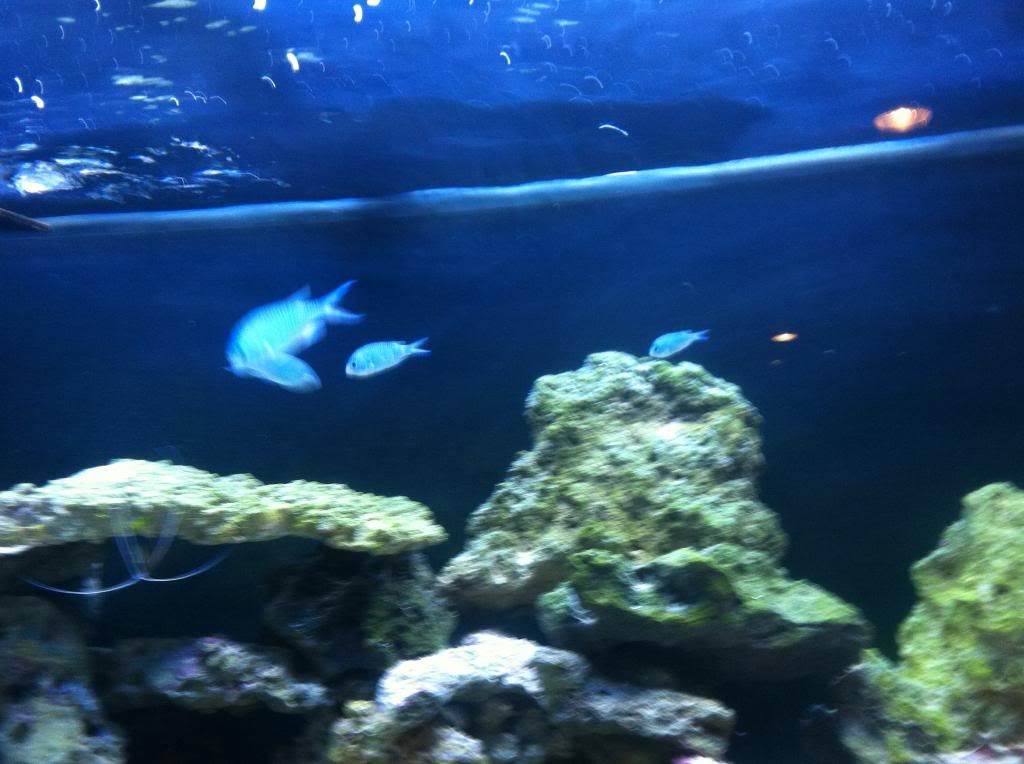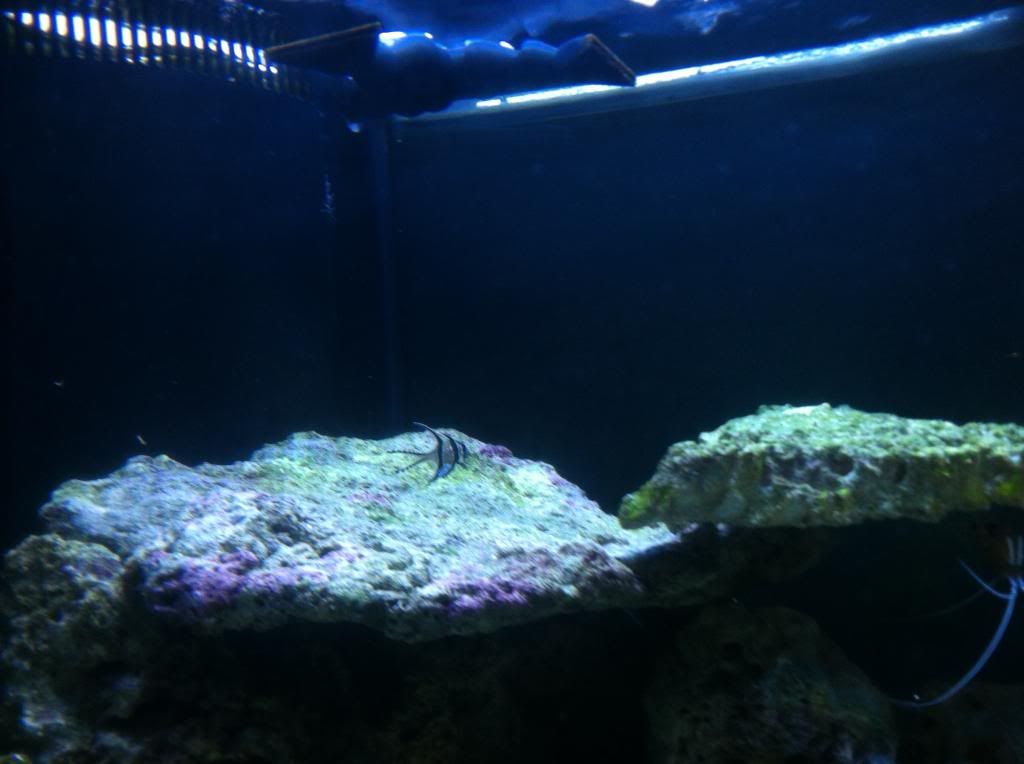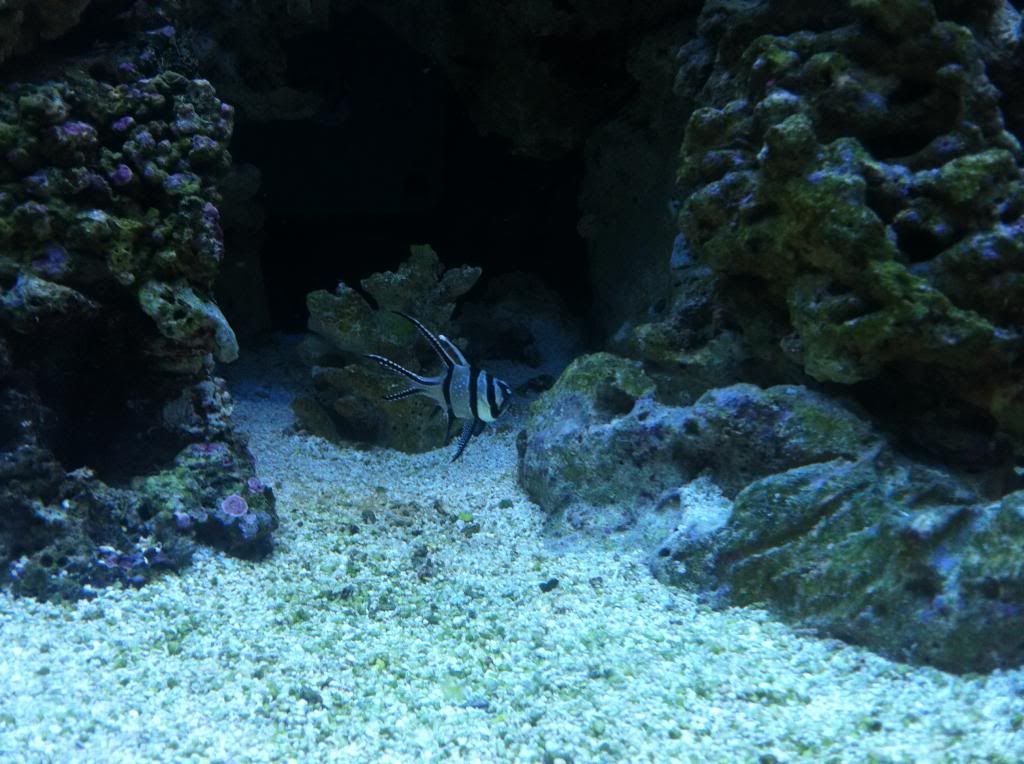This hasn't been an easy hobby set up for us for multiple of reasons that I'll get to later, but I'm hoping we've hit most of the speed bumps and pot holes now and life with the tank will be easier.
Our clean up crew have all survived (YAY!) so we bought more fish a week and a half ago.
Four blurry green chromis, they're one of the cheaper fish at only $6 a piece. We're going cheap until stuff will live longer than a week. They moved around the tank A LOT and were full of personality. We'll be getting a couple more in the future.
Two Banggai cardinalfish just like the first fish we bought. They really don't do much moving, but they're pretty cute little guys.
Sadly all but one fish didn't make it, the bigger of the two cardinals.
So I jumped onto the World Wide Web to figure out why 4 of our fish were
dying in perfect water conditions. I learned that a marine tanks need a
super high turn over of water and our sump/overflow/bulk head just
wasn't cutting it. For a fish only tank, like what we're starting out with, you need 10 to
20 times your tank volume in water turn over. If you want corals and
such you go even higher! We were getting about 800 gallons an hour with
just our sump return and when we needed more like 3000 I needed a quick
fix.
I had no idea that water flow was really that important. When the guys set up our tank they mentioned water flow, but it was in passing and they made it sound like it wasn't a huge deal. If this is why our fish were dying then it is a huge deal! It helps oxygenate the water for the fish to breath and helps push waste into the sump to be cleaned.
Since we were going out of town after we made this discovery we put in our pump that we use for water changes that moves 400 gallons an hour and hoped it would save the two fish left until a power head could be purchased.
I bought a dual power head that pushes 3200 gallons per hour from Amazon for $14 and it came while we were out of town. It's big, bulky and ugly, but the ones we really want are about $400 a pop and we'd more than likely need two and a bunch of other gear to go with it so those will have to wait a while.
Sadly we lost the last chromis last night, but I think it's because we accidentally plugged the pump into the power strip that's on the light timer so it was only turning over water 6 hours a day. I'm hoping that since we installed the power head last night our cardinal will survive and we can get more fish.
We did buy two more peppermint shrimp that have survived. John had to fish them out of the sock the day after we bought them, but since then they've stayed in the display tank and look happy. We'll be adding more snails soon, but then things we'll take a rest and we'll focus on keeping one fish alive.
I am no expert by any means, if you haven't figured that out by reading the above then you should probably click on the red X at the top right of the screen now. I do feel like I've learned a little from this hobby so far though.
1. I'm a tank dabbler who may eventually turn into a reef enthusiast based on tank personality quiz. This means that I don't want to spend a ton of time or money on the tank. More on Mark later.
2. Don't get into this hobby if you don't want to spend money.
Just getting the tank to a point where we could put water in it cost John and I thousands. Of course we did go with a big tank and it's built into the cabinetry, but surprisingly bigger is easier (eventually) and all lovers of this hobby seem to upgrade to bigger over time.
Fish and corals aren't cheap and they don't have a return guarantee if they die. Also most are taken out of the wild so if it dies you just killed Nemo. Now some fish can be tank bred and the cardinals we bought were, but most are not. This makes me extremely sad when a fish dies and until we can keep things alive I don't want to be experimenting with valuable fish.
Once you have all the equipment and things are living you're still not done spending money. You have to buy salt for water changes and the bigger tank you have the more salt you have to buy costing more money. Right now we get by just fine on a water change every two weeks and I really hope we never have to go to once a week. This means that we can't over stock our tank with fish.
Also when you start buying corals you have to buy supplements to have them thrive. So even if you want to be a tank dabbler, like me, it will still cost money.
3. RESEARCH!!! I'll be honest this is where I failed. I'm sure if I would have done better at researching we would have succeeded quicker, but I was basically doing this alone. In the 8 years I've been with John I have never seen him truly research anything. He doesn't read and he'd prefer to not use computers so it leaves me to do most of the leg work. My research usually consists of trial and error instead of digging into the facts so it was a lethal combination.
Instead of caring about how the system was supposed to work and the equipment needed, I dove into the livestock. I can tell you most of the fish names at the store, what they'd like to eat and who they're compatible with before I can tell you anything about how our RODI filter works. Not a smart move on my part.
This is also a hard hobby because there are so many different opinions that it gets overwhelming and confusing. I'd think I'd know a subject pretty well, go to the fish store and leave so confused that I was pretty sure they were speaking Russian. This is why I just had someone set the tank up because that was too over my head.
If I were to start again I'd buy Mark Callahan's guides to setting up. That way I'd only have one source to go by and wouldn't confuse myself nearly as much as I did. I still plan on buying one of his guides in hopes that it'll help us out of the money pit and into enjoying our tank.
4. and last, but not least, a silly thing I would/should have done. Put more than one electrical outlet in our canopy.
Again, when I researched I only thought of lighting and we knew we wanted LED lights so I thought that would only take up one socket, maybe two at the most. I didn't realize that it would be years before we even got the tank set up and still not have the thousands for LED lighting so we'd have to go with something cheaper.
The lights we have now heat up the tank and the canopy traps in the heat so to fight that we have to run two fans, one that runs all day and one that runs with the lights on a timer. Now we have the power head too so that comes to a total of 6 plugs that need power. I really wish we would have put in multiple outlets like we did in the sump so we couldn't have to run two power strips.
Since we've already put so much money into this I don't want to throw the towel in. I'm hoping that it will get easier and not so pricey at some point so I can actually enjoy the tank.
Wednesday, July 17, 2013
Wednesday, July 10, 2013
May's block of the month
I finished these blocks a while ago, I just kept forgetting to take pictures of them. When I was planning my class I saw this pattern in a magazine and adjusted to what I needed. Since then they have become one of my favorites and I know I'll be doing a whole quilt in this pattern one day.
They're the first of what I'm calling The Flying Geese series. In the series of 3 blocks I'm showing the 3 methods I know to make flying geese. I'd show you what a flying geese block actually is, but I'm blogging from my phone because my computer is throwing a temper tantrum and my phone is broken so I can't take a screen shot of one, just remember that google is your friend.
Anywho, without further ado here are the blocks. 

Subscribe to:
Posts (Atom)




